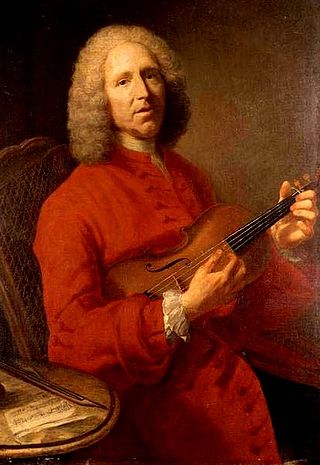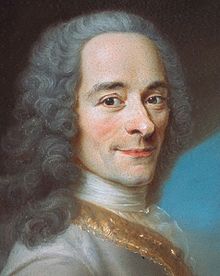
Samson and Delilah, Op. 47, is a grand opera in three acts and four scenes by Camille Saint-Saëns to a French libretto by Ferdinand Lemaire. It was first performed in Weimar at the Grossherzogliches Theater on 2 December 1877 in a German translation.

Jean-Philippe Rameau was a French composer and music theorist. Regarded as one of the most important French composers and music theorists of the 18th century, he replaced Jean-Baptiste Lully as the dominant composer of French opera and is also considered the leading French composer of his time for the harpsichord, alongside François Couperin.

Dardanus is an opera by Jean-Philippe Rameau with a French-language libretto by Charles-Antoine Leclerc de La Bruère. It takes the form of a tragédie en musique in a prologue and five acts. Dardanus premiered at the Paris Opéra on 19 November 1739 to mixed success, mainly because of the dramatic weakness of the libretto. This caused Rameau and La Bruère to rework the opera, completely rewriting the last three acts, for a revival in 1744. Only when Dardanus was again performed in 1760 did it win acclaim as one of Rameau's greatest works.

Hippolyte et Aricie was the first opera by Jean-Philippe Rameau. It was premiered to great controversy by the Académie Royale de Musique at its theatre in the Palais-Royal in Paris on October 1, 1733. The French libretto, by Abbé Simon-Joseph Pellegrin, is based on Racine's tragedy Phèdre. The opera takes the traditional form of a tragédie en musique with an allegorical prologue followed by five acts. Early audiences found little else conventional about the work.

Platée is an opera in a prologue and three acts by Jean-Philippe Rameau with a libretto by Adrien-Joseph Le Valois d'Orville. Rameau bought the rights to the libretto Platée ou Junon jalouse by Jacques Autreau (1657–1745) and had d'Orville modify it. The ultimate source of the story is a myth related by the Greek writer Pausanias in his Guide to Greece.

Les fêtes d'Hébé, ou Les talens lyriques is an opéra-ballet in a prologue and three entrées (acts) by the French composer Jean-Philippe Rameau. The libretto was written by Antoine Gautier de Montdorge (1707–1768). The work was first performed on 21 May 1739 by the Académie royale de musique at its theatre in the Palais-Royal in Paris.

Castor et Pollux is an opera by Jean-Philippe Rameau, first performed on 24 October 1737 by the Académie royale de musique at its theatre in the Palais-Royal in Paris. The librettist was Pierre-Joseph-Justin Bernard, whose reputation as a salon poet it made. This was the third opera by Rameau and his second in the form of the tragédie en musique. Rameau made substantial cuts, alterations and added new material to the opera for its revival in 1754. Experts still dispute which of the two versions is superior. Whatever the case, Castor et Pollux has always been regarded as one of Rameau's finest works.

Nélée et Myrthis is a one-act opera by Jean-Philippe Rameau in the form of an acte de ballet. Little is known about its background: the score may be incomplete and it was never staged in Rameau's lifetime. The first known performance took place at the Victoria State Opera, Melbourne, Australia on 22 November 1974. Nélée et Myrthis may have been intended to form part of a larger opéra-ballet to be called Les beaux jours de l'Amour. The name of the librettist is unknown but it was probably Rameau's frequent collaborator Louis de Cahusac.

Naïs is an opera by Jean-Philippe Rameau first performed on 22 April 1749 at the Opéra in Paris. It takes the form of a pastorale héroïque in three acts and a prologue. The librettist was Louis de Cahusac, in the fourth collaboration between him and Rameau. The work bears the subtitle Opéra pour La Paix, which refers to the fact that Rameau composed the opera on the occasion of the Treaty of Aix-la-Chapelle, at the conclusion of the War of the Austrian Succession. Its original title was Le triomphe de la paix, but criticism of the terms of the treaty led to a change in the title.

Les fêtes de Ramire is an opera in the form of a one-act acte de ballet by Jean-Philippe Rameau with a libretto by Voltaire, first performed on 22 December 1745 at the Palace of Versailles.

La naissance d'Osiris, ou La fête Pamilie is a one-act opera by Jean-Philippe Rameau, first performed on 12 October 1754 at Fontainebleau to celebrate the birth of the future King Louis XVI. The libretto is by Rameau's frequent collaborator Louis de Cahusac. Cahusac styled the work a ballet allégorique, but it is usually categorised as an acte de ballet. Its slender plot tells of Jupiter's announcement to a group of Egyptian shepherds of the birth of the god Osiris, who symbolises the baby prince. The piece may have started life as part of a larger work, Les beaux jours de l'Amour, an opéra-ballet Rameau and Cahusac planned but never completed for reasons which are still uncertain.

Io is an unfinished opera by Jean-Philippe Rameau in the form of a one-act acte de ballet. The date of its composition is unknown and it was probably unperformed during Rameau's lifetime. There is no overture or chorus and only a single dance. The score consists of recitative, arias and vocal ensembles.

Les fêtes de Polymnie is an opéra-ballet in three entrées and a prologue by Jean-Philippe Rameau. The work was first performed on 12 October 1745 at the Opéra, Paris, and is set to a libretto by Louis de Cahusac. The piece was written to celebrate the French victory at the Battle of Fontenoy in the War of the Austrian Succession. It was revived at the same venue on 21 August 1753.

Le temple de la Gloire is an opéra-ballet by Jean-Philippe Rameau with a libretto by Voltaire. The work was first performed in a five-act version on 27 November 1745 at the Grande Écurie, Versailles to celebrate the French victory at the Battle of Fontenoy. It transferred, unsuccessfully, to the Paris Opéra on 7 December 1745. A revised version, in a prologue and three acts, appeared at the Opéra on 19 April 1746.

The musical scores to several operas by the French composer Jean-Philippe Rameau have been lost. They include two major tragédies en musique, Samson and Linus, and a one-act pastoral opera Lisis et Délie. The music to these pieces was substantially complete and was performed in rehearsal but for various reasons - including censorship in the case of Samson - they were never publicly staged. Rameau also wrote a divertissement for Alexis Piron's play Les courses de Tempé, which did appear at the theatre in 1734. The music to all these works has been almost completely lost, although there is evidence Rameau reused some of it in his later operas. Rameau also began other operatic projects, which were either abandoned at an early stage (Pandore) or broken up to form shorter works.
The abbé Simon-Joseph Pellegrin (1663 – 5 September 1745) was a French poet and playwright, a librettist who collaborated with Jean-Philippe Rameau and other composers.
Antoine-César Gautier de Montdorge was a French man of letters, best known for writing the libretto for Rameau's opéra-balletLes fêtes d'Hébé (1739). Born in Lyon, he moved to Paris, where he worked as a financier. He was a friend and neighbour of Rameau's patron Alexandre Le Riche de La Pouplinière and probably met the composer at La Pouplinière's salon. Montdorge was not identified as the author of Les fêtes d'Hébé on any of its printed editions. It was first attributed to him by Antoine de Léris in the 1763 edition of his Dictionnaire portatif des théâtres. Reviewers severely criticised the literary weakness of the work. The only other opera libretto Montdorge wrote was the one-act comédie-ballet L'opéra de société for Jean-François Giraud in 1762. He described his experience working as a librettist for Rameau in the anonymously published Réflections d'un peintre sur l'opéra (1743).

Linus was an opera by Jean-Philippe Rameau with a libretto by Charles-Antoine Leclerc de La Bruère. For reasons which remain unclear it was never staged and the music is almost completely lost. Only two manuscript copies of the libretto and two manuscript copies of the violin part survive. The work takes the form of a tragédie en musique in five acts. Linus was in rehearsal in 1751 but the score was apparently stolen in confused circumstances.

Lisis et Délie was a one-act pastoral opera with music by Jean-Philippe Rameau and a libretto by Jean-François Marmontel. The musical score is now lost. It was scheduled to appear at Fontainebleau on 6 November 1753 as part of the celebrations for the birth of the royal prince Xavier, Duke of Aquitaine. It was due to form a double bill with the comédie-balletLes hommes. However, it was withdrawn from performance and "La danse", the third entrée of Rameau's Les fêtes d'Hébé, was performed in its place. The reason given for the work's cancellation was that it was too similar to Rameau's Daphnis et Eglé, premiered at Fontainebleau on 30 October. The libretto was published but the music does not survive. Rameau may have reused some of it in his later operas.
Marie-Jeanne Larrivée, born Marie-Jeanne Lemière was a French soprano.





